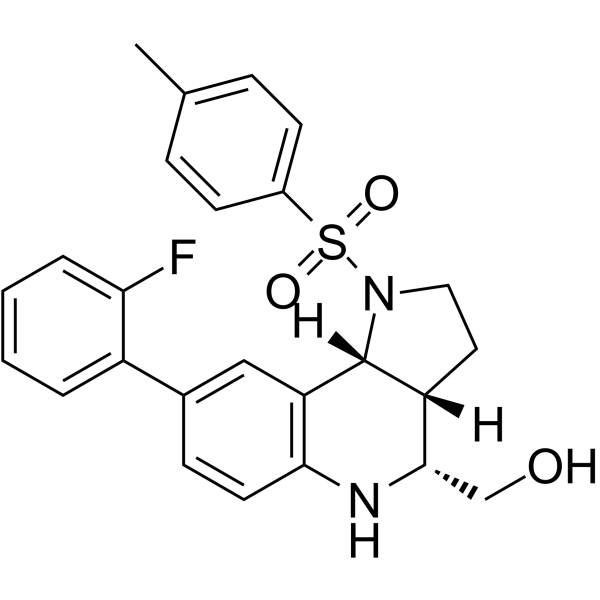Physicochemical Properties
| Molecular Formula | C25H25FN2O3S |
| Exact Mass | 452.16 |
| Elemental Analysis | C, 66.35; H, 5.57; F, 4.20; N, 6.19; O, 10.61; S, 7.08 |
| CAS # | 1403838-79-8 |
| PubChem CID | 54666326 |
| Appearance | Off-white to light yellow solid powder |
| LogP | 4.2 |
| Hydrogen Bond Donor Count | 2 |
| Hydrogen Bond Acceptor Count | 6 |
| Rotatable Bond Count | 4 |
| Heavy Atom Count | 32 |
| Complexity | 751 |
| Defined Atom Stereocenter Count | 3 |
| SMILES | CC1=CC=C(C=C1)S(=O)(=O)N2CC[C@H]3[C@@H]2C4=C(C=CC(=C4)C5=CC=CC=C5F)N[C@H]3CO |
| InChi Key | CZOIXFMISSBIJL-DCEDVJGZSA-N |
| InChi Code | InChI=1S/C25H25FN2O3S/c1-16-6-9-18(10-7-16)32(30,31)28-13-12-20-24(15-29)27-23-11-8-17(14-21(23)25(20)28)19-4-2-3-5-22(19)26/h2-11,14,20,24-25,27,29H,12-13,15H2,1H3/t20-,24+,25-/m1/s1 |
| Chemical Name | [(3aR,4R,9bR)-8-(2-fluorophenyl)-1-(4-methylphenyl)sulfonyl-2,3,3a,4,5,9b-hexahydropyrrolo[3,2-c]quinolin-4-yl]methanol |
| Synonyms | BRD0539; BRD 0539; BRD-0539 |
| HS Tariff Code | 2934.99.9001 |
| Storage |
Powder-20°C 3 years 4°C 2 years In solvent -80°C 6 months -20°C 1 month |
| Shipping Condition | Room temperature (This product is stable at ambient temperature for a few days during ordinary shipping and time spent in Customs) |
Biological Activity
| Targets | SpCas9 ( IC50 = 22 μM ) |
| ln Vitro | In a dose-dependent manner, BRD0539 inhibits the development of the DNA-bound state. The disruption brought about by the 4PAM DNA is weakened by BRD0539[1]. The interaction between SpCas9 and gRNA is not disrupted by BRD0539[1]. Further demonstrating the specificity of BRD0539, while it is able to inhibit SpCas9 in the eGFP-disruption experiment, it is unable to inhibit FnCpf1, a structurally distinct CRISPR-associated nuclease, in the same assay[1]. |
| Cell Assay | This eGFP-disruption assay reverses the BRD0539-mediated inhibition of SpCas9 by utilizing 2×105 U2OS.eGFP.The SpCas9:gRNA complex is nucleofected into PEST cells. In a 96-well plate, roughly 22,000 transfected cells/well are plated in four duplicates with 15 μM BRD0539 or DMSO. For the AcrIIA4 reversibility experiments, a preformed SpCas9:gRNA (10 pmol) is nucleofected into U2OS.eGFP.PEST cells using the previously described protocol after being incubated with AcrIIA4 (5×) for 10 min. At the designated time point (2–24 h), the media is replaced with new media that does not contain BRD0539/AcrIIA4, and the cells are allowed to grow until 24 h post-nucleofection. |
| References |
[1]. A High-Throughput Platform to Identify Small-Molecule Inhibitors of CRISPR-Cas9. Cell. 2019 May 2;177(4):1067-1079.e19. |
Solubility Data
| Solubility (In Vitro) |
DMSO : 91~100 mg/mL (201.1~221 mM) Ethanol : ~31 mg/mL (~68.5 mM) |
| Solubility (In Vivo) |
Solubility in Formulation 1: ≥ 2.5 mg/mL (5.52 mM) (saturation unknown) in 10% DMSO + 40% PEG300 + 5% Tween80 + 45% Saline (add these co-solvents sequentially from left to right, and one by one), clear solution. For example, if 1 mL of working solution is to be prepared, you can add 100 μL of 25.0 mg/mL clear DMSO stock solution to 400 μL PEG300 and mix evenly; then add 50 μL Tween-80 to the above solution and mix evenly; then add 450 μL normal saline to adjust the volume to 1 mL. Preparation of saline: Dissolve 0.9 g of sodium chloride in 100 mL ddH₂ O to obtain a clear solution. Solubility in Formulation 2: ≥ 2.5 mg/mL (5.52 mM) (saturation unknown) in 10% DMSO + 90% Corn Oil (add these co-solvents sequentially from left to right, and one by one), clear solution. For example, if 1 mL of working solution is to be prepared, you can add 100 μL of 25.0 mg/mL clear DMSO stock solution to 900 μL of corn oil and mix evenly. (Please use freshly prepared in vivo formulations for optimal results.) |
